mlusas / laravel-loom-updates
A Laravel package for tracking Loom video updates in your codebase
Installs: 105
Dependents: 0
Suggesters: 0
Security: 0
Stars: 2
Watchers: 1
Forks: 0
Open Issues: 0
pkg:composer/mlusas/laravel-loom-updates
Requires
- php: ^8.1
- guzzlehttp/guzzle: ^7.9
- laravel/framework: ^10.0|^11.0
Requires (Dev)
- orchestra/testbench: ^8.0
- phpunit/phpunit: ^10.0
README
Who is this for?
Laravel Loom Updates is designed for Laravel developers who:
- Want to enhance their code documentation with video explanations
- Need to manage and track Loom videos used throughout their codebase
- Aim to improve onboarding processes for new team members
- Desire a centralized way to view and manage code-related video content
If you're using Loom to create video explanations for your code and want an easy way to manage these videos within your Laravel project, this package is for you!
What is Laravel Loom Updates?
Laravel Loom Updates is a package that helps you track and manage Loom video links in your Laravel project's codebase. It provides tools to scan your code for Loom URLs, store them in a database, and display them in a user-friendly interface.
Features
- Scan your Laravel project for Loom video URLs
- Option to see list of Loom videos in Command Line or Web Browser
- Store Loom video metadata in your database
- Display Loom videos in a clean, responsive interface
- Artisan commands for easy management of Loom URLs
- Configurable file scanning options
Installation
You can install the package via composer:
composer require mlusas/laravel-loom-updates
After installation, run the migrations to create the necessary database table:
php artisan migrate
Configuration
Publish the configuration file:
php artisan vendor:publish --provider="mlusas\LaravelLoomUpdates\LoomUpdatesServiceProvider" --tag="config"
This will create a config/loom-updates.php file where you can modify the package settings:
return [ 'use_database' => true, 'scan_directories' => [ app_path(), resource_path(), ], 'file_extensions' => ['php', 'js', 'ts', 'vue'], ];
use_database: Set totrueto store Loom URLs in the database, orfalseto only scan files without storing.scan_directories: An array of directories to scan for Loom URLs.file_extensions: An array of file extensions to scan for Loom URLs.
Usage
Adding Loom URLs to Your Code
You can add Loom URLs to your code using the following format:
/** * @loom https://www.loom.com/share/your-video-id YYYY-MM-DD author "new Feature" */
YYYY-MM-DD: The date the video was createdauthor: The name of the person who created the videotag: A custom tag for categorizing the video (optional, enclosed in double quotes)
Example:
/** * @loom https://www.loom.com/share/1234567890abcdef 2023-09-27 John.Doe "bug" */ class ComplexAlgorithm { // ... }
Scanning for Loom URLs
To scan your project for Loom URLs and store them in the database (if use_database is true), run:
php artisan loom:store
Listing Loom URLs
To list all Loom URLs found in your codebase, use:
php artisan loom:list
You can also filter by timeframe:
php artisan loom:list --timeframe=week
Timeframe options include:
- "day"
- "week"
- "month"
Note: This command will always scan your files in real-time. If use_database is set to true, it will also check the database for any stored URLs.
The output will include the URL, file path, line number, author, date, and tag for each Loom URL found.
Viewing Loom Videos
To view the Loom videos in a web interface, add the following route to your routes/web.php file:
Route::get('/loom-videos', function () { $loomUrls = \mlusas\LaravelLoomUpdates\Models\LoomUrl::all(); return view('loom-updates::loom-viewer', compact('loomUrls')); })->name('loom-videos');
Then visit /loom-videos in your browser.
Tip: include the loom:store command in your CI/CD to scan, store, and show changes when pushed to staging or production.
Here's a preview of what the Loom viewer interface looks like:
Use Cases
- Code Documentation: Explain complex parts of your codebase with Loom videos.
- Onboarding New Developers: Help new team members understand the codebase quickly.
- Feature Demonstrations: Demonstrate new features or changes in the project.
- Bug Reporting: Visually report and explain bugs in the system.
- Code Review Explanations: Provide detailed explanations for code reviews.
- Architecture Overviews: Give high-level explanations of system architecture.
Contributing
Contributions are welcome! Please see CONTRIBUTING.md for details.
Testing
composer test
Security
If you discover any security-related issues, please email security@example.com instead of using the issue tracker.
Credits
License
The GNU General Public License v3.0 (GPLv3). Please see License File for more information.

